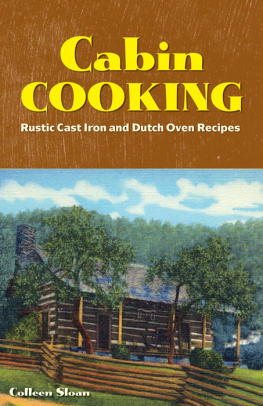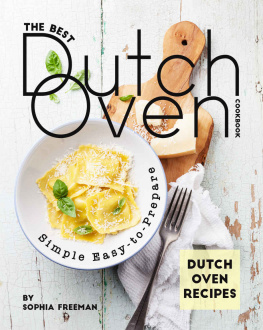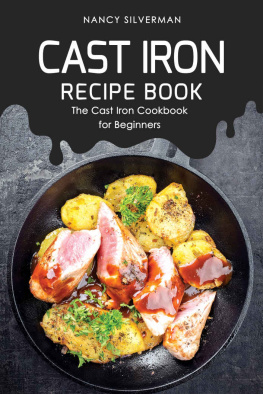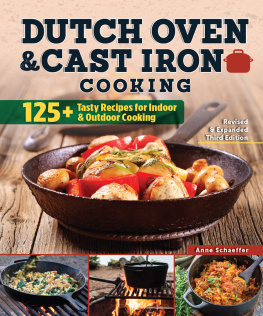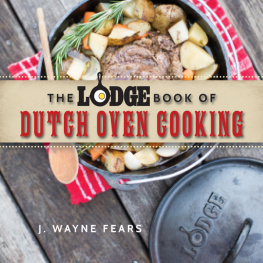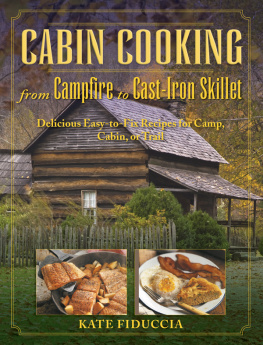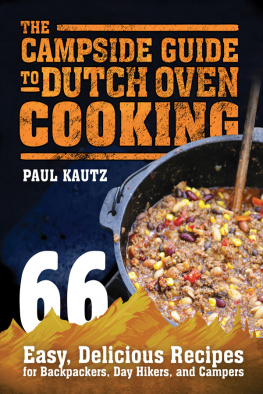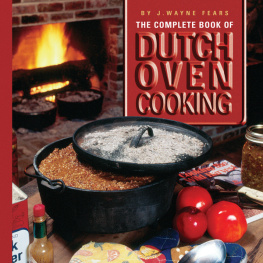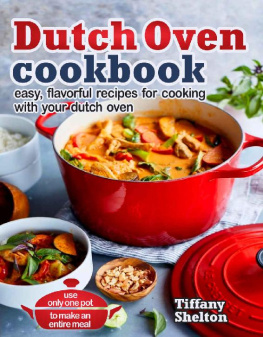Let me introduce myself to all who pick up and read this book. As of now, I am 73 years young and love every minute I can spend with all my Dutch oven cooking buddies and every cooking enthusiast I encounter. My dream was to share and gather knowledge from everyone I met. Ive done that through cooking. I have no way of naming everyone who has contributed to the knowledge I can now share with others, but most know who you are. We all touch lives that we never know abouthopefully passing on your knowledge and sharing it with others is a part of your life. The history and recipes Ive gathered are part of what I share, and so are my memories.
My children, Lisa, Steven, Larry (passed away in 1990), Justin, and Dustin, and my grandchildren and great-grandchildren are my taste testers. They also encourage me to keep going and creating. Cooking for camping trips, reunions, the Pony Express Reenactment, the Lewis and Clark Celebration, the Olympics, the IDOS organization, the Griswold and Cast Iron Collectors Society, fishing and hunting shows, company parties, birthdays, weddings, teaching classes, and demos are just a small part of what I am privileged to do. God gave me a multitude of friends and acquaintances to share withIm sure you all know who you are and I thank you. God bless all of you for being in my life.
Remember to keep those pots hot and your buns warm. Ill see you on the trail or cross your path somewhere. And, like Mom used to say, If it dont taste right, you probably left out the love.
Introduction
Icons
Next to each recipe title are icons that show the various cooking methods that can be used to prepare the food. The below list identifies the icons you will see.

Dutch Oven

Cast Iron Skillet

Kitchen Oven

Kitchen Stove Top

Camp Stove

Slow Cooker

Volcano

Barbecue

Coals
Cooking Dutch
If ever the Old West comes to mind, just pull out the black pot and hang it over the campfire on a tripod. Smell the smoke of a thousand campfires and picture the pioneer women preparing a one-pot supper after a long days walk. Hear the cowboys humming a tune as they wait for the camp cook to holler, Come and get it. Lids off! The smells of a pot of beans and Dutch oven bread make your mouth water. The name Dutch oven is used quite loosely. It actually applies to any cast iron pot with a lid on it. The bottom is flat and it may or may not have legs. My first pot did not have legs, but now, most of them do.
Seasoning Your Dutch Oven
You just bought your first Dutch oven and now youre gonna take it home. As youre leaving the store, the salesperson tells you to be sure to season it before you use it. Oh boy, youre thinking. What does that mean?
If you ask 100 people how to season a Dutch oven, youll probably get 15 different answers. Most Dutch ovens today are coated with a protective substance by the manufacturer and all you need do is scrub it in hot soapy water, rinse it thoroughly with warm water, put it on the stove and heat it to over 212 degrees to thoroughly dry it. Let it cool then lightly grease it. Never use margarine or butter to season your pot. The lowest burning oils are bacon grease, lard, vegetable oil, or shortening. I love the taste of bacon, so I use a real light coat of bacon grease when it is available.
The next step is to take it outdoors and burn the oil into the metal pot at about 500 degrees. You can do this on your propane camp stove or on your volcano outdoor stove using 30 coals.
DO NOT DO THIS IN YOUR HOUSE OVEN!
All this does is bake a protective grease coating into the pot and virtually give your pot a no-scrub surface. If the pot appears to be sticky, you need to put it back on the heat and continue to burn the oil into the metal until you have a black carbon patina finish. If your heat is around medium-low on an outdoor propane stove, it should take less than an hour to cure or season a 12-inch Dutch oven. I always turn my Dutch ovens upside down so no grease will puddle in the bottom.
Cleaning Your Oven
If your pot is seasoned well and used often, you will find it very easy to clean. I always clean my pots while hot because it eases the release of the food particles. I find it helpful to return the pot to the heat after emptying it and spray it with a little vinegar water to soften the food. I use a solution of 1 part vinegar to 4 parts water and keep it in a spray bottle in my food box so I will have it everywhere I go. Vinegar is a great disinfectant and it will remove the excess grease and stop the build-up of oil in your pot.
A lot of people will tell you never to wash the inside of your pot with soap, but I have found on occasion that I have had to. I have a pot of my dads that is over 50 years old and it has been washed several times. It has no legs and still cooks as good today as do any of my brand new ones. When you wash a cast iron pot, use only a mild detergent and always rinse it thoroughly with hot water to release the soap from the seasoning.
Always heat your pot on the stove or campfire after cleaning to dry out the moisture before storing it. It is not necessary to grease your oven before putting it away, but if you do, be sure to wipe it out thoroughly with a paper towel to avoid rancid oil build-up. Store your pots in a dry place with a clean paper towel inside to keep the moisture from rusting the surface.
These pots are not fragile, but they still require a certain amount of care. Dropping them or banging them against a hard surface could crack them and then their ability to hold the hot moisture that cooks your food is gone. You take care of them and theyll do you proud.
Using Your Dutch Oven
When using your Dutch oven for baking, the heat must be distributed on the top and bottom to maintain the proper temperature. Usually a 325 to 350 degree temperature is sufficient to bake almost any dish. If you are outside in the wind, it will take away some of your heat, but the following chart should help. You can raise or lower the temperature by adding 1 coal for every 18 to 20 degrees you wish to adjust the cooking temperature.

